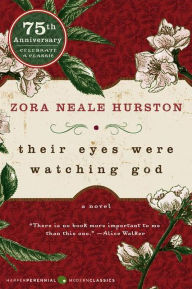During the 1920s, African-American culture in the United States received an exhilarating shot in the arm in the era known as the Harlem Renaissance. For the first time, black American art, music, and literature was being taken seriously among the intelligentsia as a significant force in contemporary culture. At the front of that movement were several writers, including Zora Neale Hurston.
Hurston's work reflected the liberation and experimentation of post-war America. She published stories and co-founded the groundbreaking journal Fire! with poet Langston Hughes and novelist Wallace Thurman. By the `30s, Hurston was a bestselling writer, but with the Renaissance on the wane and a new era of politics, economic depression, and the "social realism" movement, Hurston's once glorious literary career was running into dire straits. She would end her life destitute, practically forgotten, buried in an unmarked grave in Florida. However, a resurgence of interest in her work during the 1970s and the tireless work of writer Alice Walker would help reestablish Hurston in her rightful place as one of America's greatest and most influential writers.
Born in Eatonville, Florida, in 1891 to a father who was a Baptist preacher, Hurston was well-versed from birth in the dynamics of the Southern black experience. She brought that keen vision to her writing and published her first story in the Howard University literary magazine while attending the school in 1921. Still, it was not until Hurston moved to New York City in 1925 that she really began to make waves on the literary scene. Her writing was characterized by its unflagging honesty and strength, qualities that Hurston herself exuded. She often ruffled feathers by refusing to adhere to the constricting gender conventions prevalent at the time. This strength and self-confidence was already apparent in the writer's very first works. Her debut novel Jonah's Gourde Vine was praised by The New York Times as "the most vital and original novel about the American Negro that has yet been written by a member of the Negro race." Her second was a bona fide classic, Mules and Men, a compendium of African American folk tales, songs, and maxims that drew on Hurston's extensive studies in Anthropology.
By the time Hurston published her signature work Their Eyes Were Watching God, the freestyle experimentalism of the Harlem Renaissance was being increasingly overcast by the Great Depression. As a result, a backlash ensued. Their Eyes Were Watching God, which told of a woman named Janie Crawford who goes through three marriages to separate men as she struggles to realize herself, was too steeped in the experimentalism of the Renaissance to please critics. Furthermore, her portrayal of a black woman's search for personal liberation was too much for many black men to stomach. Richard Wright, the acclaimed author of Native Son, even dismissed Their Eyes Were Watching God for not being "serious fiction." Today, such criticism may seem absurd, or at the very least, incredibly short-sighted, but at the time, Hurston's daring prose was not in vogue amongst the social realists.
Their Eyes Were Watching God, instead, displays a true structural adventurousness, splitting between the eloquence of the narrative voice and the idiomatic, ungrammatical dialogue of the black, southern characters. While works of the social realism movement were easily categorized by their left-wing politics and gritty delivery, Their Eyes Were Watching God was less simple to pigeonhole. It is at once a product of the Harlem Renaissance, an example of Southern literature along the lines of Faulkner, and a work of feminist literature. Consequently, the novel was criticized for being out of step with the times, and it went out of print very shortly after being published, leading to the collapse of Hurston's career and her standing as a significant literary figure.
Hurston would die in 1960, back in Florida, destitute, forgotten. Her books long unavailable, her death barely registered. She would not return to the public eye until 1975, when Alice Walker published an essay titled "In Search of Zora Neale Hurston" in Ms. magazine. Along with other writer including Robert Hemenway and Tony Cade Bambara, Walker went on a crusade to revitalize Hurston's career fifteen years after the writer's death.
When Their Eyes Were Watching God was finally republished, it was reevaluated as a classic. Today, the novel is required reading in universities all over the country, and Hurston is widely acknowledged as one of the first great African-American women writers. As a final tribute to her idol, Walker also traveled to Florida where Hurston is buried and placed a marker on her grave, a long-overdue tribute to a great American writer reading with beautiful simplicity: "Zora Neale Hurston: Genius of the South."










